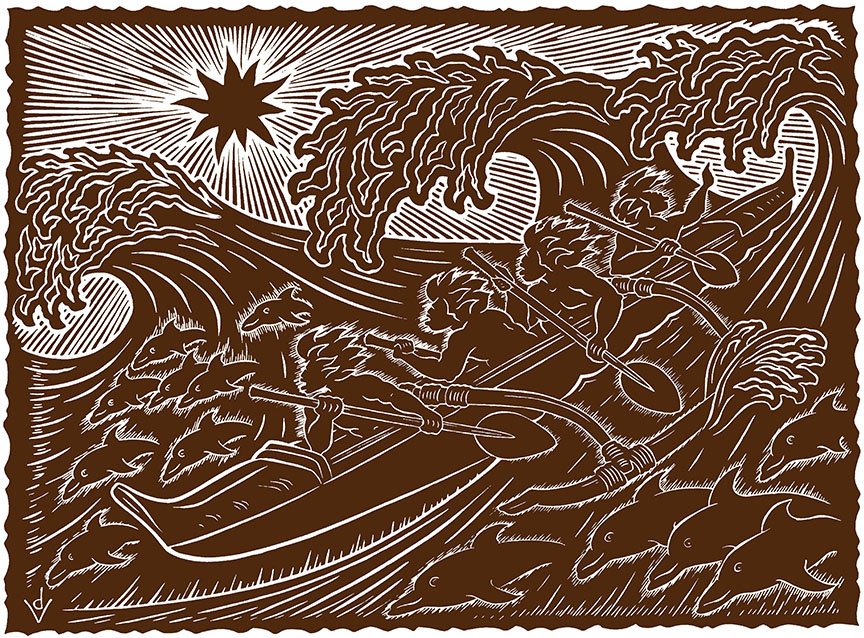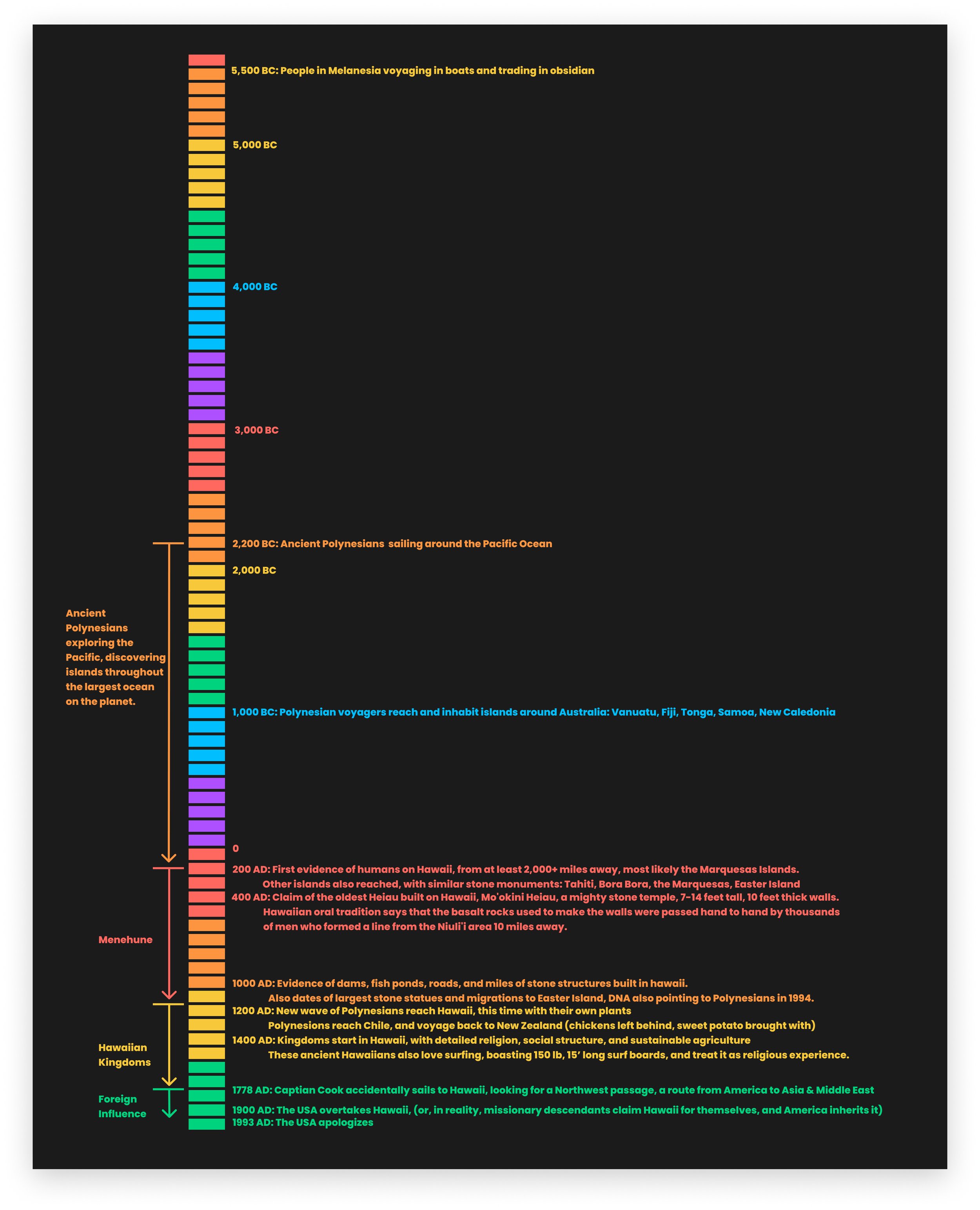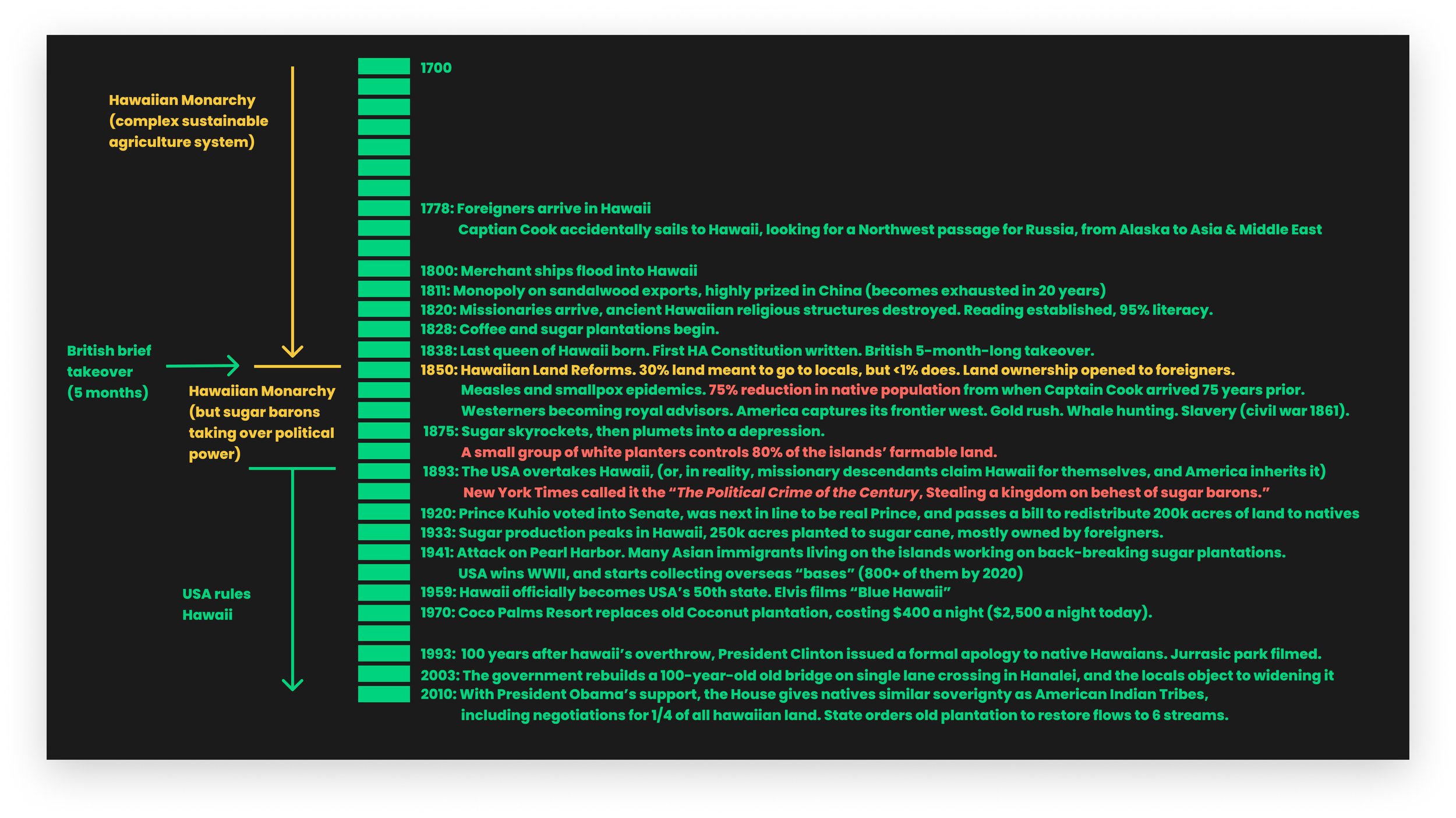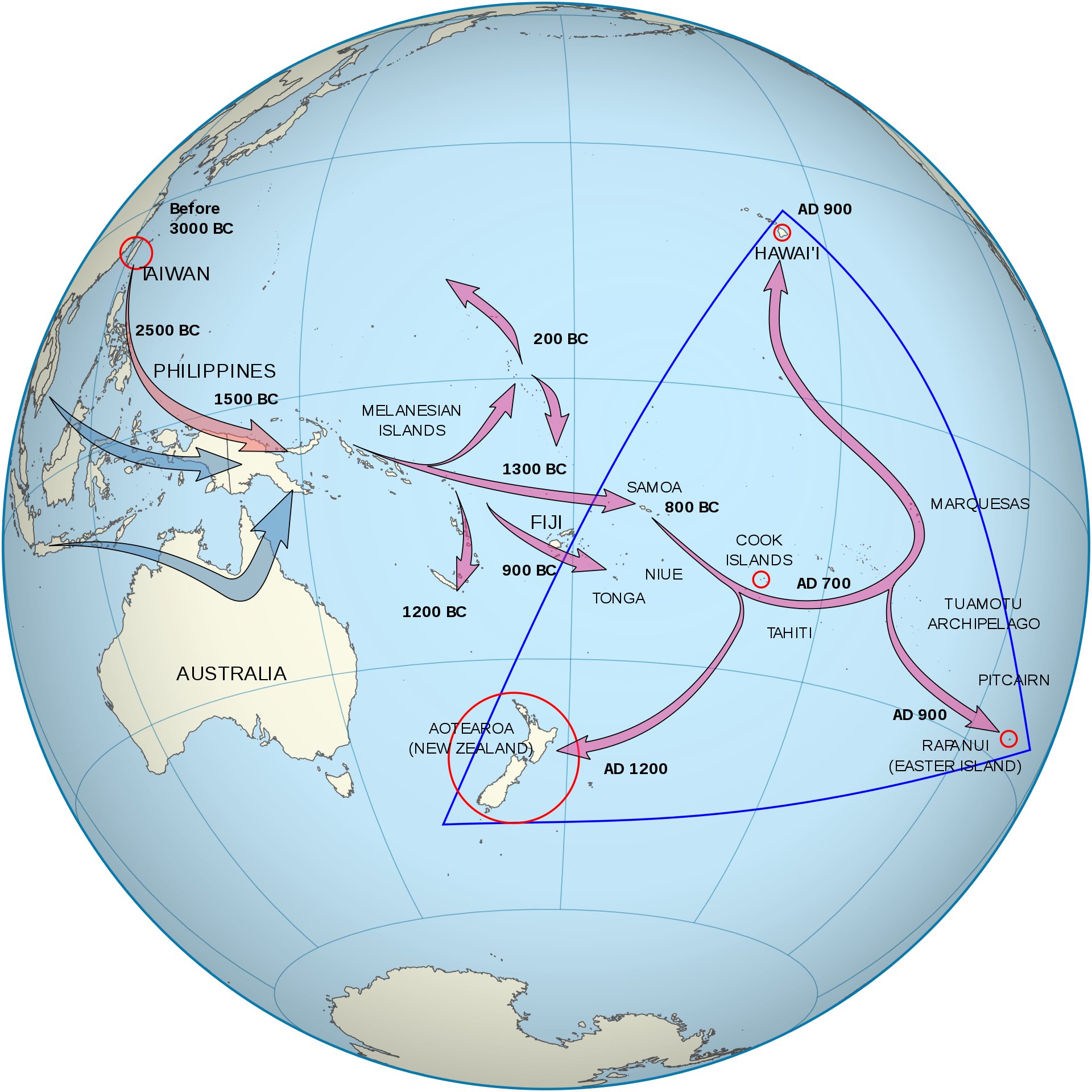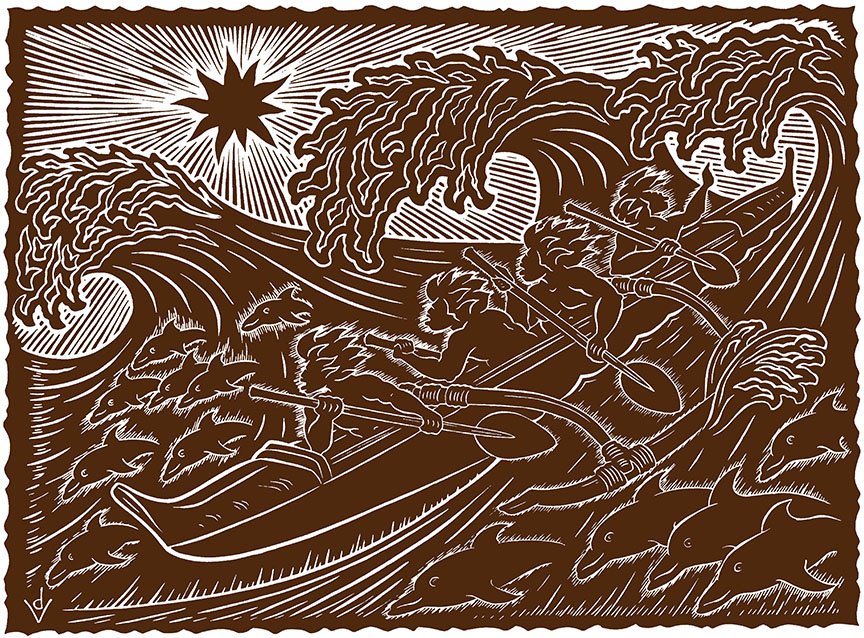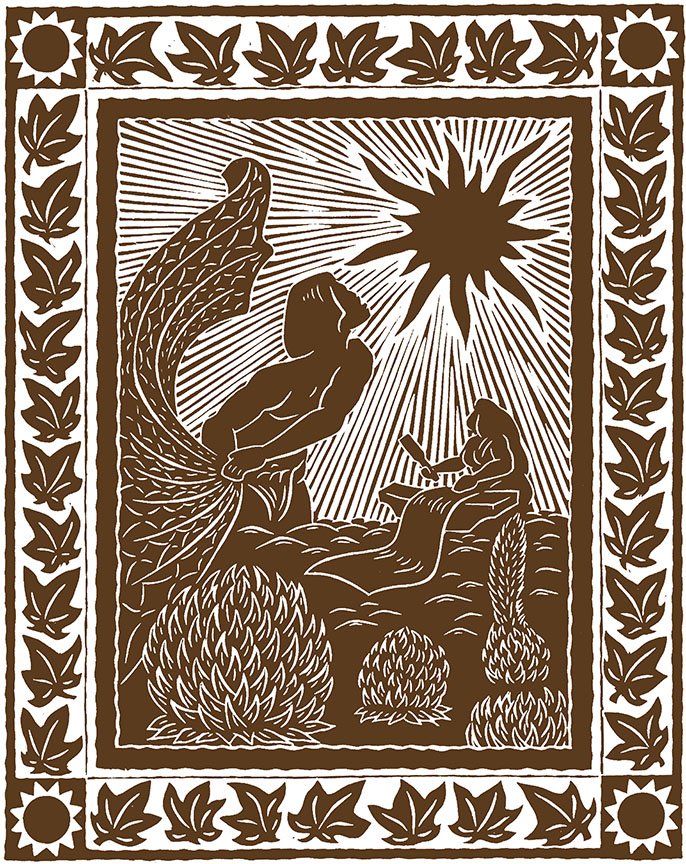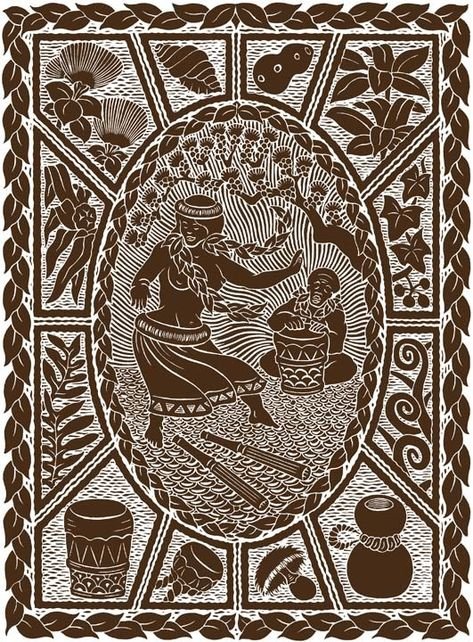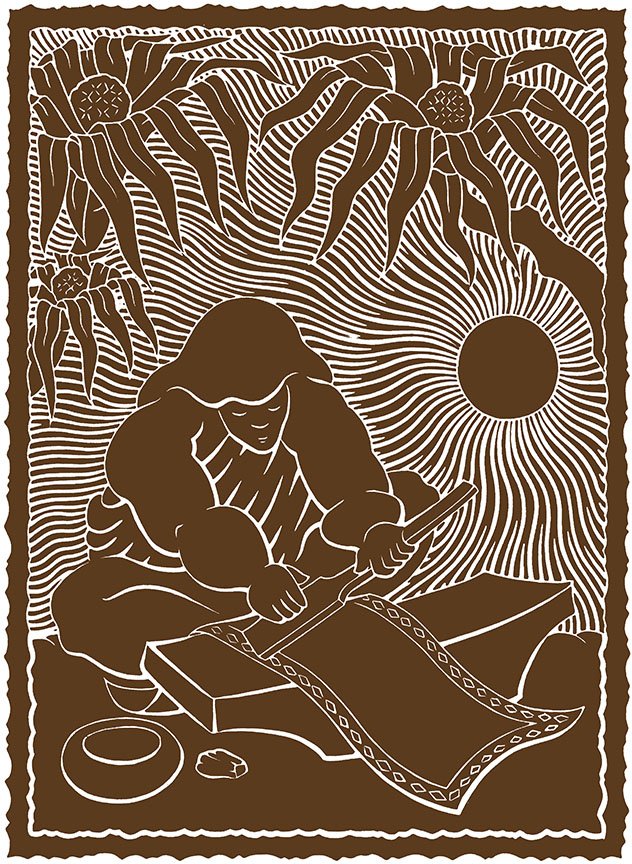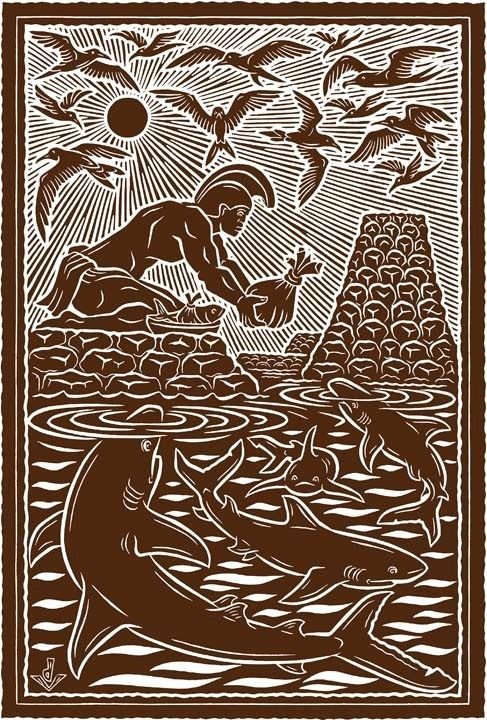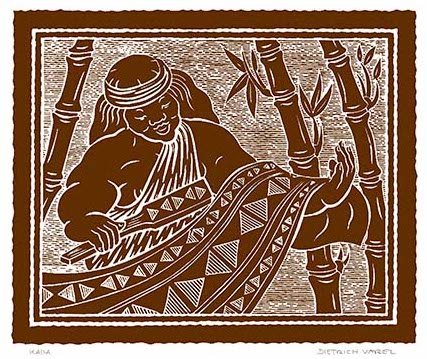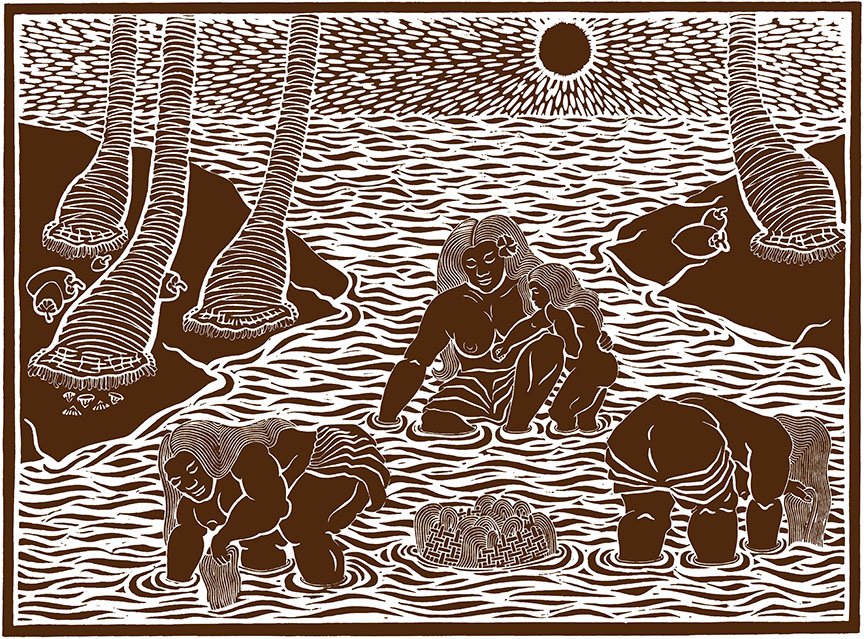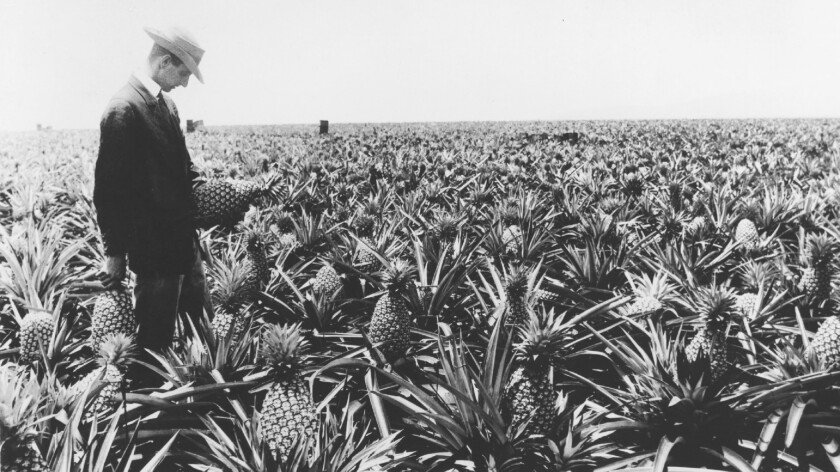Hawaii's Herstory
The Earliest Arrivals
Hawaii was populated by a group of island hoppers who had been crossing the largest ocean in the world for about 5,000 years on canoes. In the last few thousand years, they started to bring their own plants with them, learning the best foods to plant on remote islands dotting the vast expanse of water from Asia to South America.
200 AD, Menehune
Oral herstory starts in Hawaii around 1200 AD, but even these stories mention structures on the island already here before these Polynesians arrived. Modern archeological evidence supports the idea of people living on the island at least 1,000 years before the canoe planters.
The lore passed down (of a strictly oral society) mention thousands of men passing stones hand to hand for many miles to build these heiau’s without the wheel. They also found ancient fish ponds, architecture between the unique freshwater streams and salty oceans to trap fish that grow too big to swim away, leaving easy food to catch year round. Some refer to these early Hawaiians as Menehune, a term that holds mysticism and legends for the islanders.
A census in 1820 (as missionaries were populating the island) found 60 natives living in the mountains referred to as Menehune, a term meaning “lowly/little people”, designating lower status, pushed into undesirable territory (herstory repeats itself over and over). After 1861, the word starts appearing in newspapers, evolving into a cartoon-like-character similar to dwarfs and leprechauns.
Some evidence exists on the island of structures made before the more “advanced” Polynesians arrive (1k years later, 1200 AD), some with openings only 3 feet wide or so, adding to the idea these people may have been actually kind of small. But there is no skeletal evidence of this.
There is an area on Kaua'i rich breadfruit trees said to have been planted by the Menehune. What stories have you heard of these hard working people?
1200 AD, more Polynesians arrive
By 1200 AD, a second known wave of Polynesians arrive, the ones we think of today as “native Hawaiians”, with their own plants, culture, and religion. Chants give detailed stories of their day to day life.
Side Note: Native is always a relative term, based on time in a certain area. Would natives hawaiians be considered the Menehune, the first wave of explorers from the Marquesas Islands, or the ones from the same Polynesian families a thousand years later? Is it a matter of time that allows one to be called a native? Many generations vs 1? It is a term we struggle with forever more, as any single person only knows what they are told, what does collective memory serve us if it is all stories? Is it embedded in the way our bodies develop? The way we think? How strong we feel we belong?
These were the voyagers were already quite developed, with highly equipped canoes, who knew they would hit land, and could fit 50+ people PLUS all their food, plants and cargo, to live, probably indefinitely on a new, unknown, island. I wish we could learn what they were thinking, and if they ever heard of, or from, return voyagers in the same generation.
Canoe Plants
27 plants brought by Polynesians, also known as “Botanical Toolkits”, some details here.
They could even turn bark into fabric, wauke, and weave sails
carefully engineer streams for irrigation, never dividing more than half the stream at a time for preservation
plant shampoo, medicine, perfume
candles from a tree nut that burn 45 min at a time, made of 50% oil
some leaves are waxy, great for repelling water, storing food, making rain capes or sandals, or housing
Hawaiians were such prolific gardners that they had many varieties of the same plants
67 different varieties of kalo
18 kinds of kava
1400 AD, Monarchy Develops
Within 200 years, the islanders established a detailed kingdom, whose bloodline continued until foreigners arrive another 500 years later. They were known to be super healthy, strong, vibrant. But even their royal elite stood taller than the commoners.
Each of the eight populated islands was ruled by one or more chiefs. The chiefs and elite were also expected to work the lands, up until the land distribution changed completely with foreign business interests in the 1800s.
While commoners would get pulled into armies for warfare between islands, much of their time was spent in peace.
They sang, danced, and had an incredible memory for their lineage passed down in Hula chants. Designated people sifted through geneologic stories to make sure the “right” kind of marriages were happening.
They had no metal and had not discovered the wheel, yet they used stone, shells, and hardened lava for tools, and found ingenious use plants and treasures from the sea.
Ancient Surfers
Ancient surfers were knwon to ride surf boards 150 pounds, 15 feet long.
When the surf was high, entire villages rushed to the beach. Men, women, and children would paddle out to ride the rolling waves. They practiced canoe-leaping, jumping from a canoe carrying her board into a cresting ocean wave to surf to shore (similar to the boat pull today for the most daring surfers). While other Pacific Islanders also surfed, the Hawaiians took the sport to a higher level, standing fearlessly, on boards often 3x as long as the ones in Polynesia.
A sacred building, Heiau, was also built on Maui that flew different kinds of kites to signal the wave conditions at the moment.
Other locals also excelled at cliff-diving into the sea, from heights of many hundreds of feet. Even young women would strip naked and leap from the summit of high cliffs, diving headfirst with delight.
Running Competitions
Prior to being united under a single King around 1800, Hawaii was made up of multiple chiefdoms who relied on swift runners to carry messages across the islands. Every year, kukini (runners) would compete against each other at an annual festival called a makahiki.
Ahupua’a, Resiliency, Land Management
The early Hawaiian people had extremely limited resources by today’s standards.
To support their growing population on such a rainy, remote island, they designed an ingenous system of farming and water retention over many generations.
(350k+ people before Captain Cook arrived in 1778, the size of bustling San Francisco 100 years later, largest city on the west coast… but on a series of rugged volcanic islands)
ahupua literally means pig altar
the place sacrifices and goods given to the gods and ruling class ali’i
the ali’i oversaw resource sharing, splitting of the land with equal access to goods to be self sustaining
They basically split the island up like a pie, creating self sufficient communities that had access to fresh water from streams reaching at the peaks of the volcanic mountain tops, through lush forest, and down to the fish in the ocean. Each unit was a thriving self-sufficient community with all the resources it needed for food, shelter, clothing, fishing, and most important- fresh water. (the word for wealth is waiwai, water is wai).
These individual units allowed for a large population to thrive for centuries without damaging resources in any single location. Land was meticulously cultivated so as not to use any single resource up without comprimising the whole. They also had a rule to waste nothing and use only what they need.
People today study their ancient system to learn better ways to manage their land in modern times. Natives have always done a better job than colonialists, whose life depended on sustaining land in ingenious ways for thousands of years. Colonizers never audited practices, and practiced the “burn and run” approach, wearing land to the ground within a generation or less, and assuming they can find more land to ruin elsewhere. We see this in Hawaii as the foreigners arrive, shipping out lush forests to build sugar and pineapple plantations, until demand, or the land, is exhausted, and the population has to live off of imports. Even the sushi poke on Hawaii is imported in, over-fishing resulting in devastation. But before hunters and business men arrived, Hawaii thrived with life, and real food.
If you think of Hawaiians now, you may know of some of the poor health problems of the natives. As with Native Americans, once their native ways of living gave way, they were forced to live on the poverty of the American food system, exemplifying the worst of what American food brings (in health outcomes). Native Hawaiian populations today display some of the highest levels of adult obesity world-wide, and suffer disproportionately from chronic diseases of the heart, diabetes and cancer. When Captain Cook arrived in 1778, one of his crewmen note the strength of the native physique. Safe to say, they are not surfing with 150 lb surf boards anymore.
Religious Offerings
Lei Ho'okupu are gifts that are given to ensure growth and increase mana, the force that resides within all that lives.
Life revolved around ritual, and keeping the gods happy so life of plants and food and offspring would continue to prosper. Much care was taken to give back, and to take only as much as needed.
1778: Captain Cook arrives
Hawaii opens up to outsiders for the first time in 500 years.
Captain Cook received a warm welcome, mistaken for one their gods, Lono. Lucky timing, as he landed at the peak of his worship season. After 40 days of celebrating and feasting, Captain Cook was killed once they realize he was not a god. A few things clued them in.
First, the captain lost a crew member to sickness.
Then, as he tried to sail away, he shipwrecked again, and this time, they killed him.
The merchant ship was searching for the North west passage, a way to travel from North America to Russia. (Alaska at the time belonged to Russia, along with Russian ports all the way down to Sonoma coast in California).
1810: King Kamehameha unites all the Islands of Hawaii
King Kamehameha was one of the locals who jumped onto Captain Cook’s boat to see what was going on. A surgeon on Cook’s boat asked if he’d like him to explain how a compass worked, and came to regret his offer because the chief questioned him “continually until he learned it.”
This same king would welcome trading with the newcomers, amassing weapons and tactics which he used in 1810 (30 years later), to unite all the islands (and killing 10,000’s+ of locals in the process). When some islands were revolting, as in the case of Kauai, which was always the hardest to control with its rough waters, the islands were united through marriage, and saw peace again until the monarchy was abolished by the foreigners within 100 years.
Proponent of education, loving learning himself, King Kamehameha welcomed the missionaries and schools and learning for his people that were flooding in. His people were smart too, and excited to learn about the new gods and written language. Within a decade, they had 95% literacy, the highest literacy rate in the world.
But ultimately, this trust in foreigners led to disaster, when these missionaries and advisors ended up land-grabbing for themselves in the next 50 years, decimating the population with illnesses and poverty, seeing 75% reduction in native population in that same time frame.
1812: Advisors suggest a flag for the Hawaiian Kingdom
Amidst the War of 1812: over British violations of U.S. sea rights.
The royal advisors suggest a blending of the British and American flags to show neutrality.
1815: “The Islands must be made a Russian Island. Russia must have these islands at any cost!!” -Georg Schaffer
Russian fur-ship lands on Kauai, but the Hawaiian King confiscates the boat, and its goods, as his own.
The fur-trading company sends a German to recover the boat. He lands on the Hawaiian islands, and hangs out for 7 months before attempting recovery. The king id happy to return the boat for an alliance. Shaffer is given some land to support relations with what seems to be an important partner (in Russia). Schaffer declares himself chief of the north shore, what is now Princeville.
Soon, the Hawaiian King realizes Schaffer has no real power, and is kicked off the island.
1820’s Missionaries Arrive
“They came to do good, and they did well.” -local saying about the missionaries
200+ missionaries were established all across the islands to “save the souls” of the natives. These schools started with the elite children, then opened up to all communities.
But the focus was on transformation to “civilization”, which in reality, looks like cultural genocide, or wiping out of all local customs in favor of the prude ones seen elsewhere.
Sewing circles taught new ways of dress. Royal children were separated from the commoners, and new ways of thinking were introduced by way of song, religion, and speech.
In other words, they survived through attempted cultural extinction, beyond the literal 75%+ annihaliation.
And in the next generation, these missionaries were seated perfectly to act on the lax new laws allowing for land, and become the richest businesses on the island.
1820’s: Groves of Mango Trees planted as symbols of a religion no longer allowed.
As soon as the missionaries arrive, old religious structures started to be destroyed.
But this kind of mental switch never happens immediately. Even though almost all stone religious structures were destroyed, it was noticed that groves of Mango Trees seem to have been planted at the old locations, possibly in secret, to worship their old gods. The mango trees were being introduced right around this time, and known for being very large and living a long time, and can be seen growing near many old heiau locations.
1830’s: Sandalwood Trees wiped out
Within 20 years of exportation starting, the trees were wiped out on the island. Highly prized in China, where people were mortified of locals smoking the wood rather than using it for highly expensive furniture.
1838: Queen Lili’u born
The last Hawaiian queen, adopted into royalty.
Her lifetime saw:
the start of the elite schools run by missionaries, and baptism
the country’s first self-governing constitution
and the country taken away by business owners
At 4 years old, Queen Lili’u was sent to boarding school on Honolulu. The missionaries sought to protect their royal charges from bad influences by keeping them away from the rougher elements of Honolulu, as well as from their own people. Prior to this major change, all elites were expected to work the fields and be part of their communities, involved with day-to-day life. This way of life quickly changing.
1840’s: Honolulu quickly becomes a bustling port town
Full of fur traders, whalers, and all kinds of exports, the port was so crowded with ships that someone could cross the harbor by jumping from one ship’s deck to the next. At the height of the whaling season, up to 500 ships would anchor in the harbor at any one time.
Native Hawaiians composed a song describing Honolulu’s harbor crowded with masts, calling it “Ka Ulu La au o Kai,” or “Forest Trees of the Sea.”
In 1845, the Hawaiian capital moved permanently to Honolulu (from Maui).
1840: Hawaii writes its own Constitution
Giving some measure of political power to the common people with a house of representatives and supreme court.
The Hawaiian King sent a pair of emissaries to Washington, D.C., London, and Paris, seeking formal recognition of his island nation’s sovereignty as a Constitutional Monarchy
1842: United States recognized Hawaii’s independence in writing
1843 Great Britain followed
France expressed a verbal assurance soon after
1843: British weak attempt at Hawaiian takeover
Setting in place “royal advisors”, an Englishmen living in Honolulu staged a takeover of the islands, turning Hawaii, at least temporarily, into a British protectorate. Just as the scheming Englishmen rushed to send their version of events to London, so did Hawaii’s advisers prepare their own plea for justice.
After months at sea, both sets of documents reached London at the same time, where the Hawaiian kingdom’s plea prevailed.
Lord Richard Thomas, admiral of Great Britain, concluded the British coup was an embarrassment. With the simple stroke of a pen, he restored power to the Hawaiian monarchy.
Overall, the British had ruled Hawaii for just five months. The small kingdom seemed secure. But ships from even larger nations prowled its seas.
The monarchy had its first taste of the conniving schemes soon to come, with a few months of a public humbling of their once all-powerful king. Written a few days afterward,
“Our children feel very bad & many of the foreigners have expressed much sympathy for them. They feel as if their glory had departed. On Sabbath morning they all took their gold bands off from their caps saying they were no longer Chiefs.”
1848: Measels Breakout
In an official government journal, an editorial asked foreign residents to help pay for new hospitals to help the natives.
“We would like to see white men more generally engaged in relieving sufferings which white men have introduced,” asking for $100 donations apiece from the foreign community.
Thousands were killed, possibly 10% of the kingdom’s entire native population.
1853: Smallpox epidemic begins 5 years later
The native population of the islands fell to just over 71k people
50% what it had been just 30 years earlier
25% of the total from Captain Cook’s arrival 75 years prior
A perfect example of cultural genocide. Where there was not complete extinction—ways of life began to disappear, as native Hawaiians died off along with their language, stories, religion, ways of dress, and ways of making a living all shifted. Mixed-race children were born into families that often adopted Western customs
1850 Land Reforms
1.8M acres of land, now worth billions, moves from hands of the natives to American businessmen (many, the sons of missionaries).
Land was supposed to be divided out to be a 1/3 to natives, given to those currently farming it. In the end, less than 1% of the lands went to commoners. Specific wording, set in motion by foreign advisors, led intentions to be manipulated.
Former farmers became homeless, and foreigners took up the contracts to own land at extremely discounted rates meant for the locals.
The Kuleana Act encouraged commoners to file claims for land, especially lands being currently cultivated, plus an additional 1/4 acre for a house. Few natives took advantage of the act. Land had previously been granted out by the king, and the idea of owning land just did not yet make sense, they did not even have a word for it. Sometimes 1/3 of the cost of the land was expected up front, not something most farming families were able to provide.
The same year, a separate act permitted foreigners, for the first time, to own land in Hawaii. As a result, much of the most valuable land quickly slipped away from native Hawaiians and into the hands of foreigners.
1850, Hawaiian Sugar Cane Land Abuse
Huge tracts of land were set aside for plantations, in stark contrast to the self sufficient communities that immidately predated them.
With the original farmers kicked off their land with practices that thrived for 500 years, Hawaii saw its sugar exports double in value, then devastate the economy into a depression within 5 years (with increased competition seen from the Phillipines and China). Hawaii was now embedded into the market fluctuations imposed on them by much larger outside powers, forced to take part in the race to wear out soil quickest for most profit with the most desperate players in the world.
1852: Chinese immigrants first arrived as contract laborers to help with the back breaking work (that slaves were doing in other parts of the world)
By 1860 Chinese immigrant population totaled 1,200
In 1884, official census peaked of Chinese immigrants at 18,254
1861: Gently civilized nature of Hawaiian elite surprises foreigners
They found a society that included
fancy ladies’ dresses and sewing circles
moonlight rides on horseback
sea bathing at Waikiki
balls and parties, and an amateur musical society
“This is no longer a nation of barbarians, you can hardly be prepared to find them as advanced as they really are,” one woman wrote home in a series of condescending letters showing racial superiority felt at the time, a traveler on behalf of a famous British explorer.
1860: Peacocks introduced to Hawai‘i, along with Arabian jasmine from India: small, fragrant flowers used for leis. Since Princess Kai‘ulani liked both the flowers and the birds, she used the same name for them.
1861: Head of Mormon Church uses natives’ funds to purchase land for himself
Later deposed, Gibons was able to keep the land for his family.
He arrived in hawaii, just after the start of the civil war, to fill a vacancy as head of the Mormon Church on the islands, open for several years.
Using funds donated to the church by native hawaiian congregants, Gibson bought thousands of acres of land, with the deeds all in his name.
He asked the natives to work for free, to turn over much of anything they had to the church, as he wrote, “but the people are poor; in pocket, in brain, in everything." Not trying to hide disregard for the natives who were building his fortune.
Hawaiian elders soon caught on, wrote a letter, and the church excommunicated him. But he continued to acquire land, until he controlled more land than anyone else on the island.
1872: Gibson bought a hawaiian language newspaper, weighing in on elections and scandals.
1998: one of the descendants of foreign missionaries published a book, against Hawaiian Sovereignty: Do the Facts Matter, 105 years after his grandfather led the overthrow.
Castle and Cook is a real estate company that owns much of the island of Lanai, where William Gibson once shepherded his mormon flock.
1878: Water rights controversially awarded to Hotel Owner Spreckles
Claus Spreckles invited the King to his Honolulu hotel, lavished with champaign and fancy food.
In a letter sent at 2am from the King, his ministers were fired, and water rights were granted to the Hotel owner a week later.
Natives are still, today, seeking still to restore natural stream flow to support small scale farming and indigenous wildlife. Native farmers used to have a rule to never divert more than 50% flow for any purpose, so as not to disturb an ecosystem. You can be sure that private ownership did not care about the species of birds being crossed off endangered lists into extinction.
The Hawaiian word for wealth, waiwai, is just the plural to that for water, wai.
1880: The same Spreckels paid Princess Ruth $10k for half a million acres of land, which was worth $750k at the time. It seems Princess Ruth did not believe she had valid claim to the land, or did not know its value. While the deal was later overturned, he was still awarded 24k crucial acres of Waikiki.
By 1982, Spreckelsville was the largest sugarcane plantation in the world. Sugar that was once called the Spreckles plantation is now sold by C&H Sugar, company best known for its bubble gum pink boxes.
the hawaiian mamo last seen in 1898 (highly prized for yellow feathers for hundreds of years. The birds would be delicately captured and released, taking 80k birds to make one feathered cloak for a cheif)
In 2010, the State Water Commission ordered the same Spreckles plantation to restore flows to 6 streams.
1887: Bayonet Petition, an amendment to the constitution
giving non-residents right to vote
1891: Princess Liliu takes the throne
Petitions pouring in from natives asking her to replace the hated constitution from 1887.
She drew one up changing voter eligibility, giving only hawaiians right to vote (not liked by the business owners). But the bill was defeated by 24 to 17: foreigners out-numbering the natives
A mounting threat to Hawaiian’s independence came from within, the decades of sugar plantations owned by powerful white sugar planters and merchants (many descendants of missionairies who got tons of cheap land)
to annex the islands to the US, the primary consumers of Hawaiian sugar
1893: USS Boston, an American warship with special orders to protect U.S. interests, steamed into the Honolulu harbor
2 days after the queen’s attempt to introduce a new constitution
a crowd of roughly 1000+ white men were electrified by the son of one of the first missionaries on the island, a now lawyer, founder of the Annexation club
spoke in a booming voice that reached the back of the hall, asking, “Has the tropic sun cooled and thinned our blood, or have we flowing in our veins the warm, rich blood which makes men love liberty and die for it?” (seeming to forget the liberty afforded to other people)
Thurston sent a message to the American ship USS Boston, and within a few hours, there was an order to land 162 American sailors onto the nearly deserted streets Honolulu at 5pm.
Why had the troops landed on such a peaceful night? The landing of U.S. Marines came after decades of tension between Hawaiians and America.
events leading up to it are passionately debated even today among legal scholars, Hawaiian rights activists, and historians, since it lands at the crux of the story of how Hawai‘i became part of the United States and is at the heart of the racial conflict that still tears at the state
Until recently, American history textbooks have largely overlooked how a small group of businessmen, many of whom were descendants of early Christian missionaries, managed to overthrow a soverign, fully independent, kingdom.
1893: Wanting to prevent a massacre on her own lands, Queen Liliu surrendered, with a carefully worded protest
perhaps thinking back to 1843, where the british restored power to the hawaiians after 5 months
“I Queen, do protest against any acts done abainst myself and the Hawaiian Kingdom by certaon persons claiming to have establisehd a provisional government for this Kingdom. THat I yeld to the superior force of the United States of America who have landed tropps at Honolulu to support the said provisional government. TO avoid any collision of armed forces and loss of life, I do under this protest, yield my authority until such a time as the US goernment undo the action of its representatives and reistate me in the authority as the constitutional socvereign of teh Hawaiian Islands.”
Dole signed the back of teh protest indicating he recieved it. She yielded power to the US rather than the provisional government, refusing to abdicate. The wording of her protest, drafted by her lawyer would be subject to lenghty US congressional testimony and debate. What should have been a minor coup in a remote kingdom turned into an internaltional incident.
favorable stories in the American press, questioning the actions of Thurston, Dole and their provisional government.
the New York Herald concluded the revolution was “of, by, and for sugar”
St Louis Chronicle that the “revolution was not a movement of th epeople, but by those not permitted by the queen to plunder the land"
New York Times rand a story headlined “A Shameful Conspiracy in which the S was made to pla a part”, “The Political Crime of the Century”
stealing a kingdom on behest of sugar barons.
Grover Clevelland had doubts of teh overthrow, and planned to withdraw the annexation treaty,
1893, findings sent to the US secretary of state, and President Cleveland, conclusions unambiguously in Liliu’s favor: illegally overthrown with the help of the presence of US Marines
“That a deep wound has been done the Queen and the native race by American officials, there can be no doubt. The President of the US had no knowledge of these occurrences and must make a decision at a future time” -Blout
descendants of the christians who;d arrived 7 decades earlier with a mission to save souls, not steal a country
with the overthrow, the crown lands, almost a million acres was assumed by the new government.
1894: Hearings resulting in a 1176 page report, contradicting Blout’s findings in 1893
asserting that Hawaii is an American state, in which Liliu was trying to grasp absoulte power and destroy the constitution and rights of the white people.”
President Cleveland had to decide which way to enforce the requests, meaning ordering US troops to go to war agaist the disobedient sons of American missionaries.
Though neither Thurston or Dole could claim to be American citizens, born in hawaii, and now leading a provisional government, WITHOUT the backing of the US Congress.
At the same time, America was seeing itself taking on its own frontiers, and a Pulitzer price winning book argued the “safety valve” on western expansion was now gone, and and the country would be looking beyond its continental borders for new markets. Imperialism it is.
meanwhile, a constitution was made even more difficult for poor, uneducated hawaiian workders to gain a vote in government.
1898: America’s annexation (ownership) of Hawai‘i
1898: Dole family start of the pineapple enterprise
Sanford Dole becoming the first governor of Hawaii after its annexation, then a federal district judge
The sugar businessmen quickly adapted and decided to switch gears to… the pineapple
This delicious tropical fruit has become the iconic symbol of Hawaii.
It became the number one industry in the islands and eventually produced more than 90% of the world's pineapple.
A large pineapple cannery stood at the spot where the hotel was that we just saw that was where the pineapple was canned and shipped all over the world.
1917: Queen Liliu’s death
still commemorated today, especially her legacy of music and her beautiful voice, each year performred at teh annyal Merrie Monarch Festival on the islands.
Her most famous song, “Aloha Oe” sung by elvis and Lilo and Stitch.
Letters in her later years testament to her lost land and fortune. Bitter lawsuits in her later years made it difficult for her to trust anyone.
She left the bulk of her estate, $200k ($5M today) into a trust, causing her second cousing to file a lawsuitm though the trust still exists today, managing 6.4k acres of land inherited from her mother.
The trust has over 370k+ acres, along with various schools founded by her sister.
In contrast, Zuckerberg now owns 1.5k acres in Hawaii
1919: Many Hawaiians lost the rights to the lands they had lived on for generations
to say it was not fair would be an understatement Prince Kūhiō was actually next in line to be the king of Hawaii.
Kūhiō (Prince of the People) is well known for his efforts to preserve and strengthen the Hawaiian people. Instead of being a king, Prince Cohero managed to get elected as a us Senator. One of his greatest concerns was the welfare of his people and he introduced and help pass a bill to redistribute over 200,000 acres of land back to the Hawaiian people.
And thanks to him. There is land on every island on Hawaiian, still homestead, even to this day.
1941: Attack on Pearl Harbor (Hawaii a territory, not a state)
1959: Hawaii became Americas 50th State
1957-1970s: Elvis
1961: Blue Hawaii filmed, and elvis proposed to the starlet actress Joan Freeman, featured in 2 of his movies, but denied
1993: 100 years after Hawaii’s overthroww, President Clinton issued a formal apology to native Hawaians
1994: Hurricane, jurrasic park movie crew hiding out in basement of the hotel
2010, with President Obama’s support, the House passed legislation giving natives similar sovcerignty as American Indian Tribes, including negotiations for a quater of all haweaiian land.

